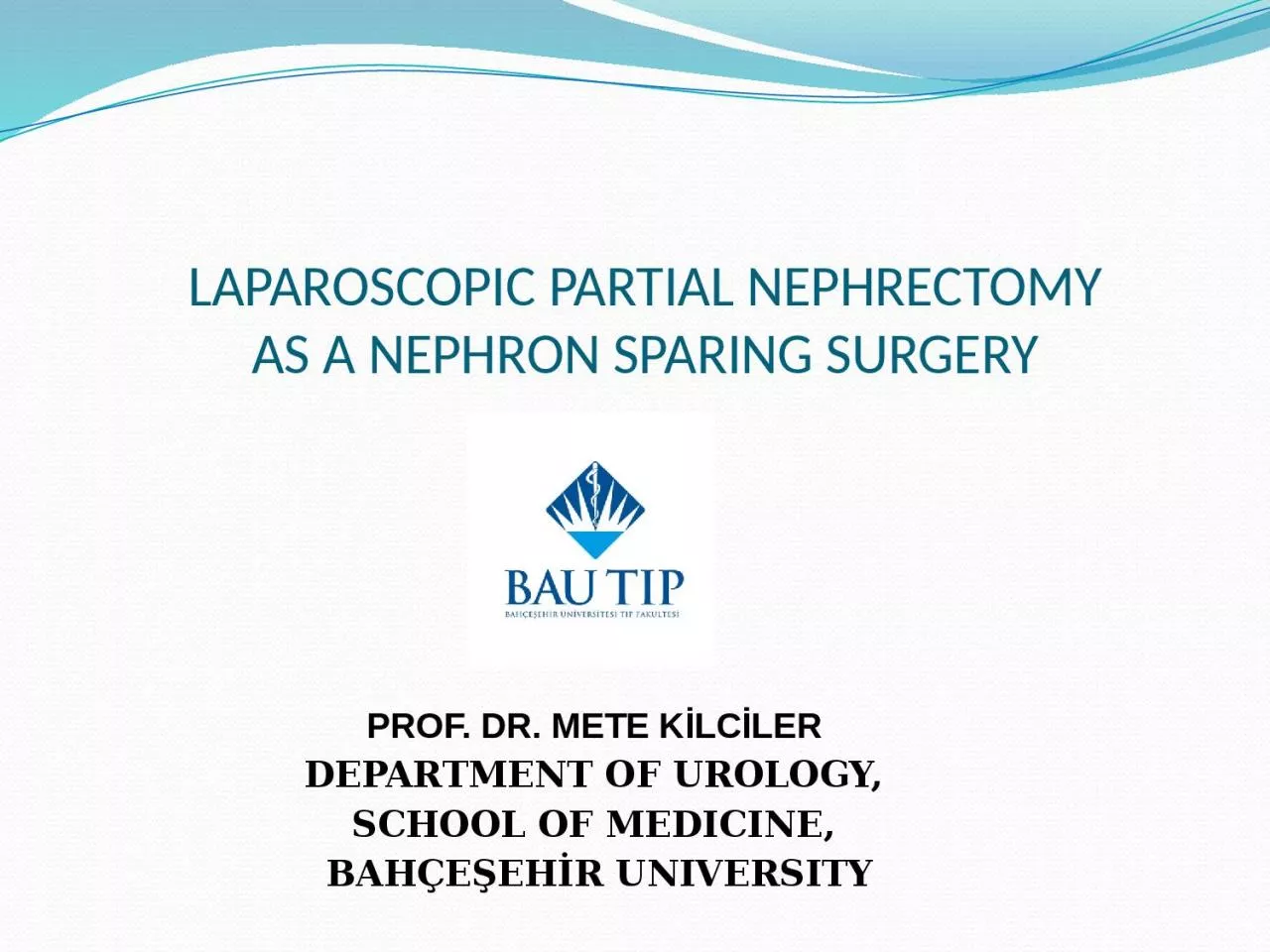

AS A NEPHRON SPARING SURGERY PROF DR METE KİLCİLER DEPARTMENT OF UROLOGY SCHOOL OF MEDICINE BAHÇEŞEHİR UNIVERSITY Introduction The incidence of small incidental renal tumors is increasing ID: 932136
Download Presentation The PPT/PDF document "LAPAROSCOPIC PARTIAL NEPHRECTOMY" is the property of its rightful owner. Permission is granted to download and print the materials on this web site for personal, non-commercial use only, and to display it on your personal computer provided you do not modify the materials and that you retain all copyright notices contained in the materials. By downloading content from our website, you accept the terms of this agreement.
Slide1
LAPAROSCOPIC PARTIAL NEPHRECTOMY AS A NEPHRON SPARING SURGERY
PROF. DR. METE KİLCİLER
DEPARTMENT OF UROLOGY,
SCHOOL OF MEDICINE,
BAHÇEŞEHİR UNIVERSITY
Slide2IntroductionThe incidence of small incidental renal tumors is increasingNephron-sparing surgery -new trendNSS - 4 cm or small localized RCC (Novick)
Open partial nephrectomy
-
gold standard
Slide3IntroductionThe first LPN was described in 1993 (J. Endourol,7:521,1993)It is an advanced laparoscopic procedure Dissection, renal
hilum clamping, renal
parenchymal
hemostasis
,
pelvicaliceal
reconstruction
and
renorraphy
Steps
are essentially duplicating those of open partial
nephrectomy
Slide4IndicationsClassical indications:Small renal tumorsPeripheral locationSuperficialExophyticAs the surgeon’s experience increases
:more complex tumors can be done
tumors
invading the parenchyma to the collecting system
,
or
renal
sinus
complete
intrarenal
tumors
tumor
in a solitary
kidney
Slide5ContraindicationsRenal vein thrombusMultiple renal tumorsLocally advanced diseaseBleeding diathesisMorbid obesityPrior renal surgeryGeneral C/I to laparoscopic surgery
Slide6C/I to lap. surgeryAbsolute contraindications:Uncorrectable coagulopathyIntestinal obstructionAbdominal wall infectionMassive hemoperitoniumPeritonitis
Suspected malignant ascites
Slide7C/I to lap. surgeryRelative contraindications:Morbid obesityPrior abdominal or
pelvic s
urgery
Pelvic
f
ibrosis
Organomegaly
Ascites
Pregnancy
Hernia
Iliac or
a
ortic
a
neurysm
Slide8Pre-op. PreparationSame as for open surgeryBasic blood countAccurate stagingThree dimensional CT scan
Slide9Informed consent (for lap and open) Bowel prep (empty bowel)Foley catheter (empty bladder)NG or OG tube (empty stomach)DVT prophylaxis (sequential compression stockings) +/- AntibioticsShave prepPre-op. Preparation
Slide10Surgical techniqueTransperitonealanteriorantero-lateral
lateralupper pole
-
apical
Retroperitoneal
p
osterior
posterolateral
Lower
pole
Slide11approach
depends
on
localization
of
tumor
Slide12Transperitoneal
Position
Slide13Retroperitoneal Position
Slide14Retroperitoneal Access
Slide15Surgical technique-1Cystoscopy, ureteral catheterizationPort placementBalloon dilatation
(for retroperitoneal
way
)
Mobilizing
the
colon
(
for
transperitoneal
way
)
Hilar
dissection
Mobilize
the
kidney
and
dissect
fat
tissue
Identify tumor
Laparoscopic
us
and circumferential
scoring
Clamping
vessels
Slide16Surgical technique-2Tumor excisionRenal tumor bed biopsy and frozen sectionPelvicaliceal repair (if necessary)
Sutures
to control transected
parenchymal
vessels
Hemostatic
renorraphy
over
bolsters
Unclamp
hilum
, confirm
hemostasis
Jackson-Pratt drain
Slide17Hemostatic techniquesArgon beam coagulatorElectrocauteryHarmonic scalpelFibrin glueGelatin spongesUltrasonic surgical aspiratorLaserMicrowave tissue coagulator
Slide18Surgical technique – TLPN position
Slide19Surgical technique – RLPN position
Slide20TLPN TechniqueIndividual dissection of the renal artery and vein is not necessary Laparoscopic satinsky clamp is used to control the renal
hilum en bloc
The
inset shows a four-port arrangement, with a 2-mm needle port positioned
laterally
Slide21RLPN TechniqueOwing to the somewhat restricted retroperitoneal operative space, the Satinsky clamp is not used Instead, the renal artery and vein are dissected individually and controlled with separate laparoscopic bulldog clamps Inset
shows the three-port retroperitoneoscopic approach
Slide22Bigger tumors or unclear parenchyma borders need ultrasound and experienced radiologist
Slide23Lap. Partial nephrectomyTumor excision performed with cold EndoshearsThe calyx abutting the tumor is entered deliberately, as necessary, to maintain an adequate parenchymal margin
Slide24Lap. Partial nephrectomy Retrograde injection of indigo carmine through an indwelling ureteral catheter precisely describe the site of caliceal entry in the partial nephrectomy
bed
Slide25Lap. Partial nephrectomy Caliceal suture repair performed using intracorporeal freehand laparoscopic suturing. A CT-1 needle with 2-0 Vicryl is employed to achieve a watertight closure.
Slide26Lap. Partial nephrectomyRenal parenchymal reconstruction A GS-25 needle with 0 Vicryl is employed to place wide parenchymal sutures
Typically, three to four sutures are needed.
Slide27Lap. Partial nephrectomy Pre-prepared bolsters of surgicel are placed in the parenchymal defect before cinching down the sutures.
Slide28Warm ischemia time < 30 min Tumor excision
Suturing collecting
system
Suturing
parenchyma
Slide29Complications of Laparoscopic Partial NephrectomyUrinoma Total nephrectomy Trocar site infection
PneumothoraxPulmonary edema
Tumor fragmentation
Transfusion
Pneumonia
Renal insufficiency
Slide30Financial analysisItem
Lap.
Open
P value
Intraop
.
c
ost
20.1% greater
< 0.001
Postop. cost
55% lesser
< 0.001
Overall hospital cost
15.6% lesser
0.002
Slide31ConclusionsLPN is an advanced procedureCarries higher intraop./postop. complicationsAs surgeon experience increases, the rate of complications decreases, and the indications for more complex cases increasesEmerging as a viable and efficient treatment option in the minimally invasive armamentarium